key SKODA YETI 2012 1.G / 5L Owner's Guide
[x] Cancel search | Manufacturer: SKODA, Model Year: 2012, Model line: YETI, Model: SKODA YETI 2012 1.G / 5LPages: 225, PDF Size: 5.47 MB
Page 56 of 225
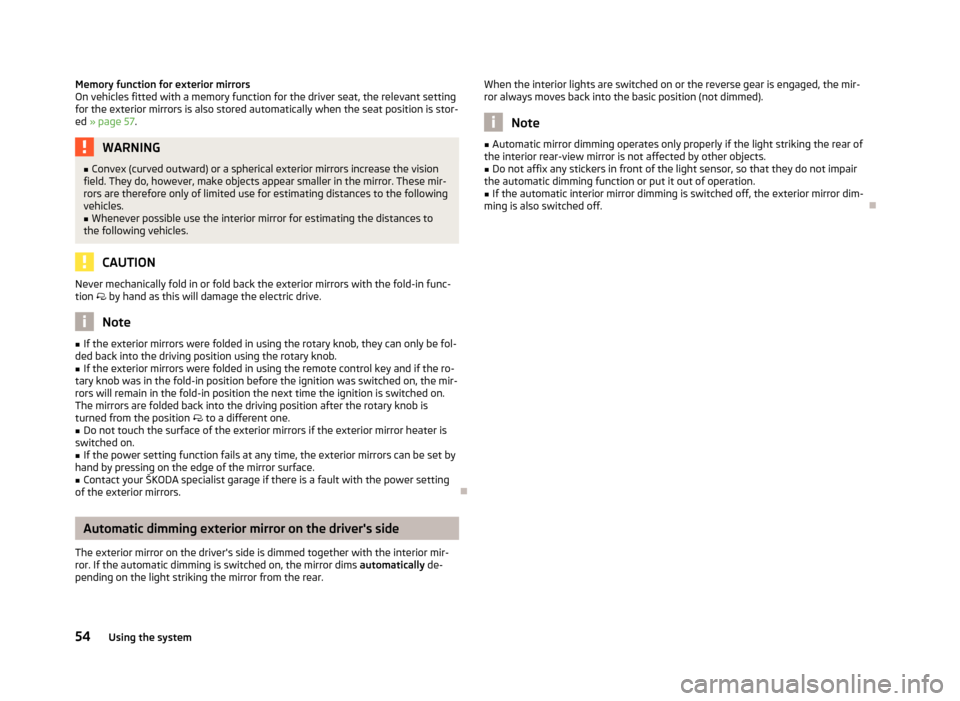
Memory function for exterior mirrors
On vehicles fitted with a memory function for the driver seat, the relevant setting
for the exterior mirrors is also stored automatically when the seat position is stor-
ed » page 57 . WARNING
■ Convex (curved outward) or a spherical exterior mirrors increase the vision
field. They do, however, make objects appear smaller in the mirror. These mir-
rors are therefore only of limited use for estimating distances to the following
vehicles.
■ Whenever possible use the interior mirror for estimating the distances to
the following vehicles. CAUTION
Never mechanically fold in or fold back the exterior mirrors with the fold-in func-
tion by hand as this will damage the electric drive. Note
■ If the exterior mirrors were folded in using the rotary knob, they can only be fol-
ded back into the driving position using the rotary knob. ■ If the exterior mirrors were folded in using the remote control key and if the ro-
tary knob was in the fold-in position before the ignition was switched on, the mir-
rors will remain in the fold-in position the next time the ignition is switched on.
The mirrors are folded back into the driving position after the rotary knob is
turned from the position to a different one.
■ Do not touch the surface of the exterior mirrors if the exterior mirror heater is
switched on. ■ If the power setting function fails at any time, the exterior mirrors can be set by
hand by pressing on the edge of the mirror surface. ■ Contact your ŠKODA specialist garage if there is a fault with the power setting
of the exterior mirrors. ÐAutomatic dimming exterior mirror on the driver's side
The exterior mirror on the driver's side is dimmed together with the interior mir-
ror. If the automatic dimming is switched on, the mirror dims automatically de-
pending on the light striking the mirror from the rear. When the interior lights are switched on or the reverse gear is engaged, the mir-
ror always moves back into the basic position (not dimmed). Note
■ Automatic mirror dimming operates only properly if the light striking the rear of
the interior rear-view mirror is not affected by other objects. ■ Do not affix any stickers in front of the light sensor, so that they do not impair
the automatic dimming function or put it out of operation.
■ If the automatic interior mirror dimming is switched off, the exterior mirror dim-
ming is also switched off. Ð54
Using the system
Page 57 of 225
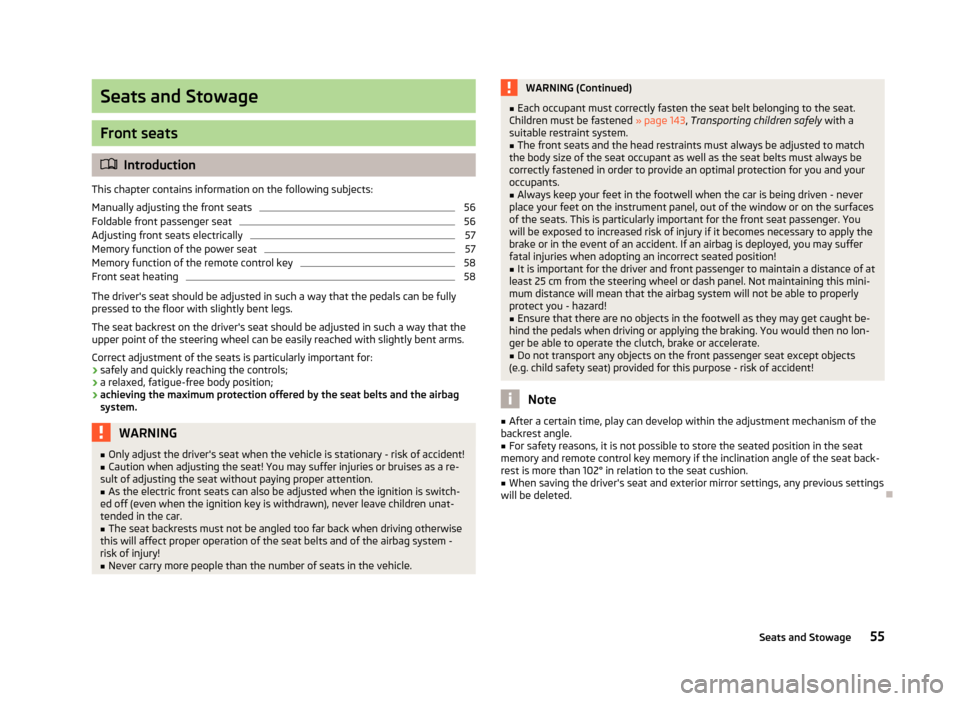
Seats and Stowage
Front seats
ä
Introduction
This chapter contains information on the following subjects:
Manually adjusting the front seats 56
Foldable front passenger seat 56
Adjusting front seats electrically 57
Memory function of the power seat 57
Memory function of the remote control key 58
Front seat heating 58
The driver's seat should be adjusted in such a way that the pedals can be fully
pressed to the floor with slightly bent legs.
The seat backrest on the driver's seat should be adjusted in such a way that the
upper point of the steering wheel can be easily reached with slightly bent arms.
Correct adjustment of the seats is particularly important for:
› safely and quickly reaching the controls;
› a relaxed, fatigue-free body position;
› achieving the maximum protection offered by the seat belts and the airbag
system. WARNING
■ Only adjust the driver's seat when the vehicle is stationary - risk of accident!
■ Caution when adjusting the seat! You may suffer injuries or bruises as a re-
sult of adjusting the seat without paying proper attention. ■ As the electric front seats can also be adjusted when the ignition is switch-
ed off (even when the ignition key is withdrawn), never leave children unat-
tended in the car. ■ The seat backrests must not be angled too far back when driving otherwise
this will affect proper operation of the seat belts and of the airbag system -
risk of injury! ■ Never carry more people than the number of seats in the vehicle. WARNING (Continued)
■ Each occupant must correctly fasten the seat belt belonging to the seat.
Children must be fastened » page 143, Transporting children safely with a
suitable restraint system.
■ The front seats and the head restraints must always be adjusted to match
the body size of the seat occupant as well as the seat belts must always be
correctly fastened in order to provide an optimal protection for you and your
occupants.
■ Always keep your feet in the footwell when the car is being driven - never
place your feet on the instrument panel, out of the window or on the surfaces
of the seats. This is particularly important for the front seat passenger. You
will be exposed to increased risk of injury if it becomes necessary to apply the
brake or in the event of an accident. If an airbag is deployed, you may suffer
fatal injuries when adopting an incorrect seated position!
■ It is important for the driver and front passenger to maintain a distance of at
least 25 cm from the steering wheel or dash panel. Not maintaining this mini-
mum distance will mean that the airbag system will not be able to properly
protect you - hazard!
■ Ensure that there are no objects in the footwell as they may get caught be-
hind the pedals when driving or applying the braking. You would then no lon-
ger be able to operate the clutch, brake or accelerate.
■ Do not transport any objects on the front passenger seat except objects
(e.g. child safety seat) provided for this purpose - risk of accident! Note
■ After a certain time, play can develop within the adjustment mechanism of the
backrest angle. ■ For safety reasons, it is not possible to store the seated position in the seat
memory and remote control key memory if the inclination angle of the seat back-
rest is more than 102° in relation to the seat cushion.
■ When saving the driver's seat and exterior mirror settings, any previous settings
will be deleted. Ð
55
Seats and Stowage
Page 58 of 225
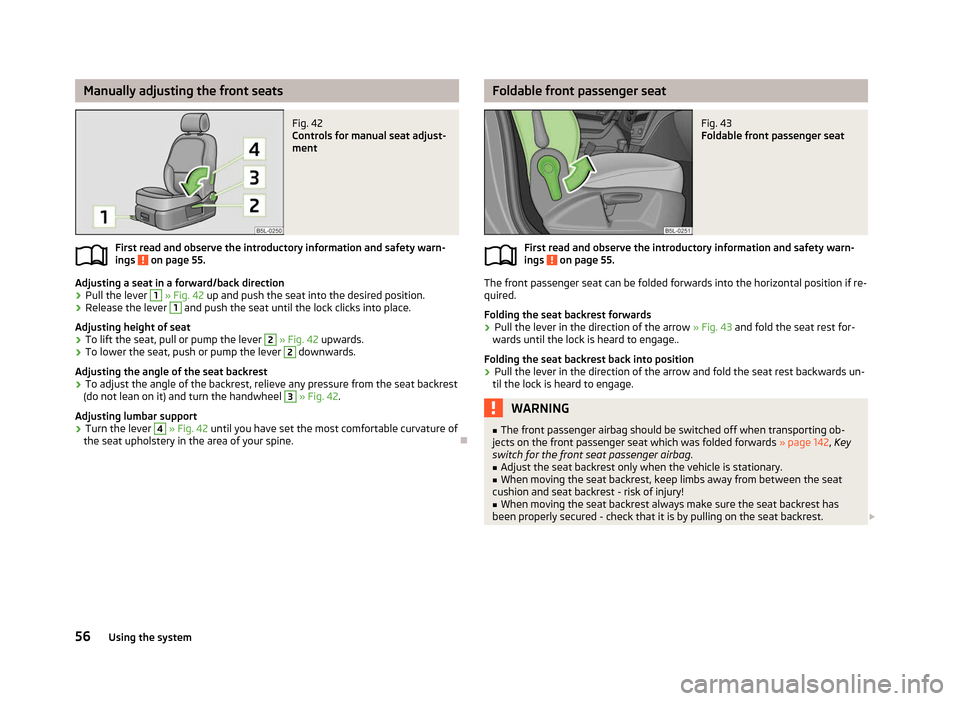
Manually adjusting the front seats
Fig. 42
Controls for manual seat adjust-
ment
First read and observe the introductory information and safety warn-
ings on page 55.
Adjusting a seat in a forward/back direction
›
Pull the lever 1
» Fig. 42 up and push the seat into the desired position.
› Release the lever 1
and push the seat until the lock clicks into place.
Adjusting height of seat
› To lift the seat, pull or pump the lever 2
» Fig. 42 upwards.
› To lower the seat, push or pump the lever 2
downwards.
Adjusting the angle of the seat backrest
› To adjust the angle of the backrest, relieve any pressure from the seat backrest
(do not lean on it) and turn the handwheel 3
» Fig. 42.
Adjusting lumbar support
› Turn the lever 4
» Fig. 42 until you have set the most comfortable curvature of
the seat upholstery in the area of your spine. Ð
ä Foldable front passenger seat
Fig. 43
Foldable front passenger seat
First read and observe the introductory information and safety warn-
ings on page 55.
The front passenger seat can be folded forwards into the horizontal position if re-
quired.
Folding the seat backrest forwards
› Pull the lever in the direction of the arrow
» Fig. 43 and fold the seat rest for-
wards until the lock is heard to engage..
Folding the seat backrest back into position
› Pull the lever in the direction of the arrow and fold the seat rest backwards un-
til the lock is heard to engage. WARNING
■ The front passenger airbag should be switched off when transporting ob-
jects on the front passenger seat which was folded forwards » page 142, Key
switch for the front seat passenger airbag .
■ Adjust the seat backrest only when the vehicle is stationary.
■ When moving the seat backrest, keep limbs away from between the seat
cushion and seat backrest - risk of injury!
■ When moving the seat backrest always make sure the seat backrest has
been properly secured - check that it is by pulling on the seat backrest. £
ä
56 Using the system
Page 59 of 225

WARNING (Continued)
■ If the front passenger seat backrest is folded, passengers may only be con-
veyed on the outer seat behind the driver.
■ Never transport objects on the seat backrest which was folded forwards,
which: ■ impair driver visibility;
■ make it impossible for the driver to control the vehicle, e.g. if they are
placed under the pedals, or could protrude into the driver's zone;
■ could lead to injury to passengers due to a change of direction or braking
manouvre when accelerating sharply. ÐAdjusting front seats electrically
Fig. 44
Controls for the electric seat adjustment
First read and observe the introductory information and safety warn-
ings on page 55.
Adjusting a seat in a forward/back direction
›
Press the switch B
» Fig. 44
forwards or backwards in the direction of arrow 1.
Set the height of the seat cushion
› Press the switch B
»
Fig. 44
upwards or downwards.
Adjust the angle of the seat cushion
› Press the switch B
»
Fig. 44
in the direction of the arrow 2 or 3.
Adjusting the angle of the seat backrest
› Press the switch C
»
Fig. 44
in the direction of the desired setting.
ä Reducing or increasing the curvature of the lumbar support
› Press the switch A
»
Fig. 44
forwards or backwards.
Raising or lowering the curvature of the lumbar support
› Press the switch A
»
Fig. 44
upwards or downwards.
The adjusted driver's seat position can be set in the memory of the
seat » page 57 or the remote control key » page 58. Note
If the movement of the seat is inadvertently interrupted during an adjustment,
once again press the switch in the appropriate direction and complete the adjust-
ment of the seat. Ð Memory function of the power seat
Fig. 45
Memory buttons and SET button
First read and observe the introductory information and safety warn-
ings on page 55.
The memory function for the driver's seat provides the option to store the individ-
ual positions of the driver's seat and the external mirrors. A setting position can
be allocated to each of the three memory buttons B
» Fig. 45, i.e. three in total.
Storing seat and exterior mirror settings for driving forward
› Switch on the ignition.
› Adjust the seat to the desired position.
› Adjust both of the exterior mirrors
» page 53.
› Press the button
SET A
» Fig. 45.
› Within 10 seconds after pressing the
SET button, press the desired memory
button B
.
An acknowledgment sound confirms the storage in the seat memory. £
ä
57
Seats and Stowage
Page 60 of 225

Storing exterior mirror setting for reversing
›
Switch on the ignition.
› Press the required memory button B
» Fig. 45.
› Move the rotary knob for the exterior mirror control into position
» page 53.
› Engage reverse gear.
› Move the right exterior mirror into the desired position
» page 53.
› Take the vehicle out of gear.
The adjusted position of the exterior mirror is stored in the seat memory.
Retrieving the saved setting
The retrieval is possible when turned the ignition is switched on and the vehicle
speed is less than 5
km/h or when the ignition key is inserted in the ignition lock.
› Press and hold the desired memory button B
» Fig. 45 for a short while.
Stopping the ongoing adjustment
› Press any button on the driver's seat.
› The movement can be stopped by pressing the button
on the remote control
key and opening the driver's door. Note
Each time new seat and exterior mirror settings for forward travel are saved, the
individual setting for the right exterior mirror for reverse travel must also be
saved again. ÐMemory function of the remote control key
First read and observe the introductory information and safety warn-
ings on page 55.
The automatic storage function of the driver's seat and exterior mirrors position
when locking the vehicle
can be turned on in the memory of the remote control
key. When unlocking the vehicle with the same key, the driver's seat and the ex-
terior mirrors assume the positions stored in the memory of this key.
Activating the function
› Unlock the vehicle with the remote control key.
› Press and hold any memory button B
» Fig. 45 on page 57. After the seat has
assumed the position stored under this button, at the same time press the but-
ton on the remote control key within 10 seconds.
The successful activation of the function is confirmed by an audible signal. ä Deactivating the function
› Unlock the vehicle with the remote control key.
› Press and hold the
SET button A
» Fig. 45 on page 57. At the same time, press
the button on the remote control key within 10 seconds.
The successful deactivation of the function is confirmed by an audible signal.
Stopping the ongoing adjustment
› Press any button on the driver's seat.
› The movement can be stopped by pressing the button
on the remote control
key and opening the driver's door. Ð Front seat heating
Fig. 46
Dash panel: Control for heating
the front seats
First read and observe the introductory information and safety warn-
ings on page 55.
The seat backrests and seats can be heated electrically.
The seat heating can only be switched on when the engine is running.
The seat heaters on the driver's and front passenger's seat can be switched on
and regulated by pressing the button in the area of the symbol or » Fig. 46 .
By pressing the button once, the heating is switched to the highest intensity -
level
3, which is indicated by all three of the indicator lights in the switch lighting
up.
With repeated pressing of the switch, the intensity of the heating is down-regula-
ted up to the switch-off. The intensity of the heating is indicated by the number
of illuminated indicator lights in the switch. £
ä
58 Using the system
Page 69 of 225

Remove variable loading floor
Fig. 61
Boot: Fold up variable loading floor/remove
Remove variable loading floor › Fold up the loading floor by moving it in the direction of the arrow 1
» Fig. 61.
› Fold up the variable loading floor in direction of arrow 2
.
› Pull on both sides of the locking levers in direction of arrow 3
.
› Remove the variable loading floor in direction of arrow 4
.
› The variable loading floor is installed in the reverse order.
Secure the variable loading floor in the raised position
› Fold up the hooks on the fastening strip in direction of arrow 1
» Fig. 57 on
page 64
.
› Fold up the variable loading floor behind the rear back backrests.
› Fold down the hooks in direction of arrow 3
as far as the stop.
› Support the variable loading floor on the hooks folded downwards. Ð Removing and installing carrier rails
Fig. 62
Slacken check points/remove carrier rails
Removing
› Slacken the check points B
»
Fig. 62
on the carrier rails using the vehicle key
or a flat screwdriver.
› Grasp the carrier rail A
at position 1
and slacken it by pulling in the direction
of arrow.
› Grasp the carrier rail A
at position 2
and slacken it by pulling in the direction
of arrow.
Install
› Position the carrier rails on the sides of the boot.
› Press both check points on each carrier rail B
up to the stop.
› Check the attachment of the carrier rails by pulling it. WARNING
Pay attention when installing the variable loading floor that the carrier rails
and the variable loading floor are correctly fixed, otherwise the occupants are
at risk. Ð
67
Seats and Stowage
Page 73 of 225
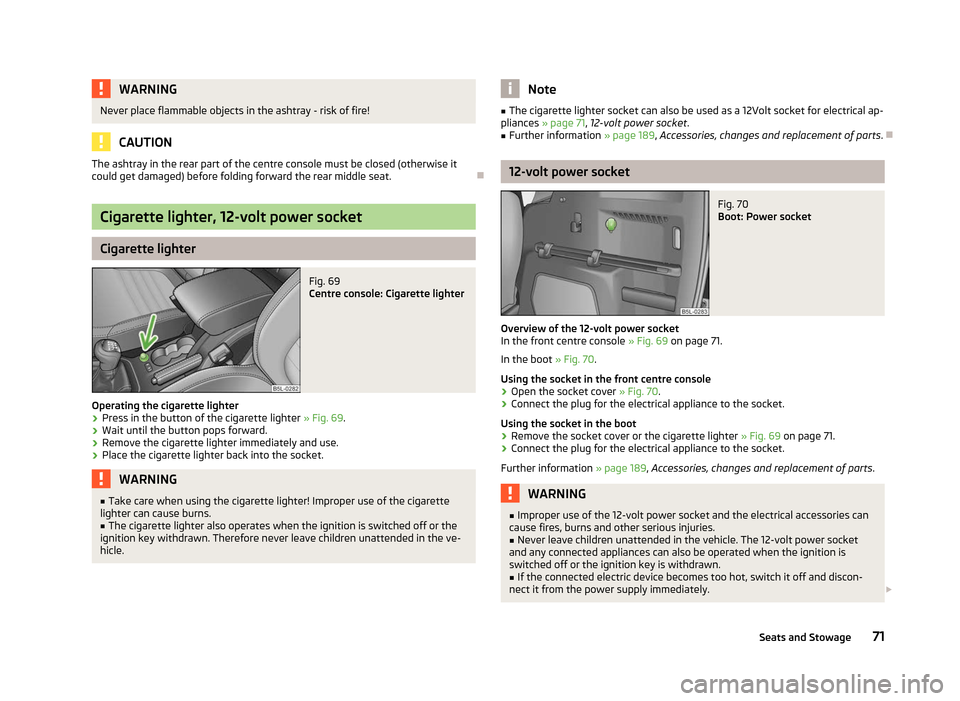
WARNING
Never place flammable objects in the ashtray - risk of fire! CAUTION
The ashtray in the rear part of the centre console must be closed (otherwise it
could get damaged) before folding forward the rear middle seat. ÐCigarette lighter, 12-volt power socket
Cigarette lighter
Fig. 69
Centre console: Cigarette lighter
Operating the cigarette lighter › Press in the button of the cigarette lighter
» Fig. 69.
› Wait until the button pops forward.
› Remove the cigarette lighter immediately and use.
› Place the cigarette lighter back into the socket. WARNING
■ Take care when using the cigarette lighter! Improper use of the cigarette
lighter can cause burns. ■ The cigarette lighter also operates when the ignition is switched off or the
ignition key withdrawn. Therefore never leave children unattended in the ve-
hicle. Note
■ The cigarette lighter socket can also be used as a 12Volt socket for electrical ap-
pliances » page 71 , 12-volt power socket.
■ Further information » page 189, Accessories, changes and replacement of parts .Ð 12-volt power socket
Fig. 70
Boot: Power socket
Overview of the 12-volt power socket
In the front centre console » Fig. 69 on page 71.
In the boot » Fig. 70.
Using the socket in the front centre console
› Open the socket cover
» Fig. 70.
› Connect the plug for the electrical appliance to the socket.
Using the socket in the boot
› Remove the socket cover or the cigarette lighter
» Fig. 69 on page 71.
› Connect the plug for the electrical appliance to the socket.
Further information » page 189, Accessories, changes and replacement of parts . WARNING
■ Improper use of the 12-volt power socket and the electrical accessories can
cause fires, burns and other serious injuries.
■ Never leave children unattended in the vehicle. The 12-volt power socket
and any connected appliances can also be operated when the ignition is
switched off or the ignition key is withdrawn.
■ If the connected electric device becomes too hot, switch it off and discon-
nect it from the power supply immediately. £
71
Seats and Stowage
Page 92 of 225
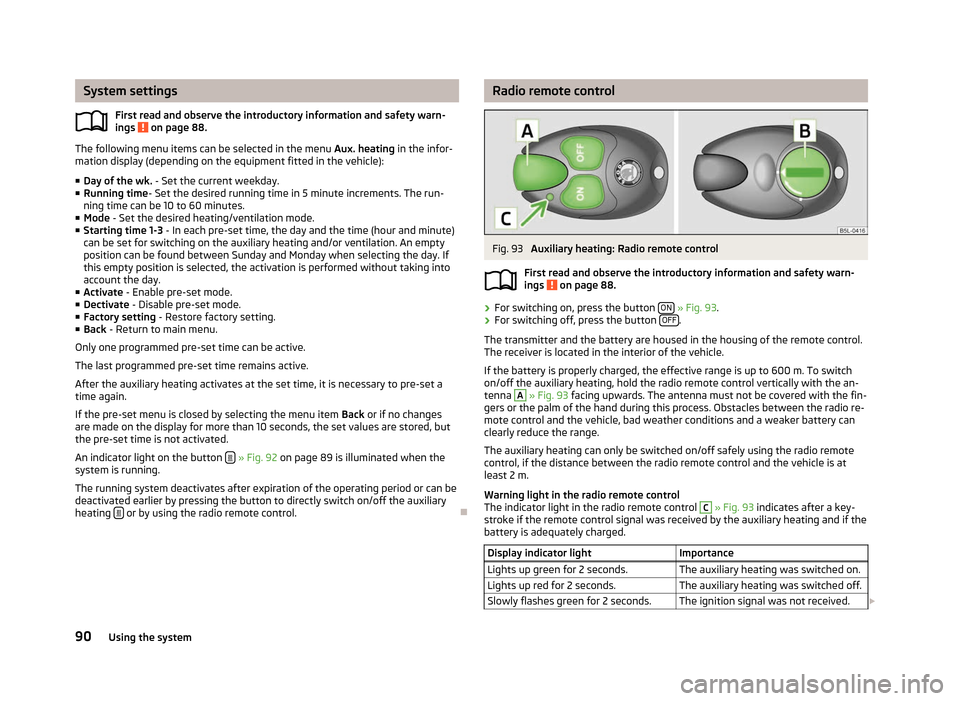
System settings
First read and observe the introductory information and safety warn-
ings on page 88.
The following menu items can be selected in the menu
Aux. heating in the infor-
mation display (depending on the equipment fitted in the vehicle):
■ Day of the wk. - Set the current weekday.
■ Running time- Set the desired running time in 5
minute increments. The run-
ning time can be 10 to 60 minutes.
■ Mode - Set the desired heating/ventilation mode.
■ Starting time 1-3 - In each pre-set time, the day and the time (hour and minute)
can be set for switching on the auxiliary heating and/or ventilation. An empty
position can be found between Sunday and Monday when selecting the day. If
this empty position is selected, the activation is performed without taking into
account the day.
■ Activate - Enable pre-set mode.
■ Dectivate - Disable pre-set mode.
■ Factory setting - Restore factory setting.
■ Back - Return to main menu.
Only one programmed pre-set time can be active.
The last programmed pre-set time remains active.
After the auxiliary heating activates at the set time, it is necessary to pre-set a
time again.
If the pre-set menu is closed by selecting the menu item Back or if no changes
are made on the display for more than 10 seconds, the set values are stored, but
the pre-set time is not activated.
An indicator light on the button » Fig. 92 on page 89
is illuminated when the
system is running.
The running system deactivates after expiration of the operating period or can be
deactivated earlier by pressing the button to directly switch on/off the auxiliary
heating or by using the radio remote control.
Ð
ä Radio remote control
Fig. 93
Auxiliary heating: Radio remote control
First read and observe the introductory information and safety warn-
ings on page 88.
›
For switching on, press the button
ON » Fig. 93.
› For switching off, press the button
OFF .
The transmitter and the battery are housed in the housing of the remote control.
The receiver is located in the interior of the vehicle.
If the battery is properly charged, the effective range is up to 600
m. To switch
on/off the auxiliary heating, hold the radio remote control vertically with the an-
tenna A
» Fig. 93 facing upwards. The antenna must not be covered with the fin-
gers or the palm of the hand during this process. Obstacles between the radio re-
mote control and the vehicle, bad weather conditions and a weaker battery can
clearly reduce the range.
The auxiliary heating can only be switched on/off safely using the radio remote
control, if the distance between the radio remote control and the vehicle is at
least 2
m.
Warning light in the radio remote control
The indicator light in the radio remote control C
» Fig. 93 indicates after a key-
stroke if the remote control signal was received by the auxiliary heating and if the
battery is adequately charged.
Display indicator light Importance
Lights up green for 2 seconds. The auxiliary heating was switched on.
Lights up red for 2 seconds. The auxiliary heating was switched off.
Slowly flashes green for 2 seconds. The ignition signal was not received. £ ä
90 Using the system
Page 94 of 225
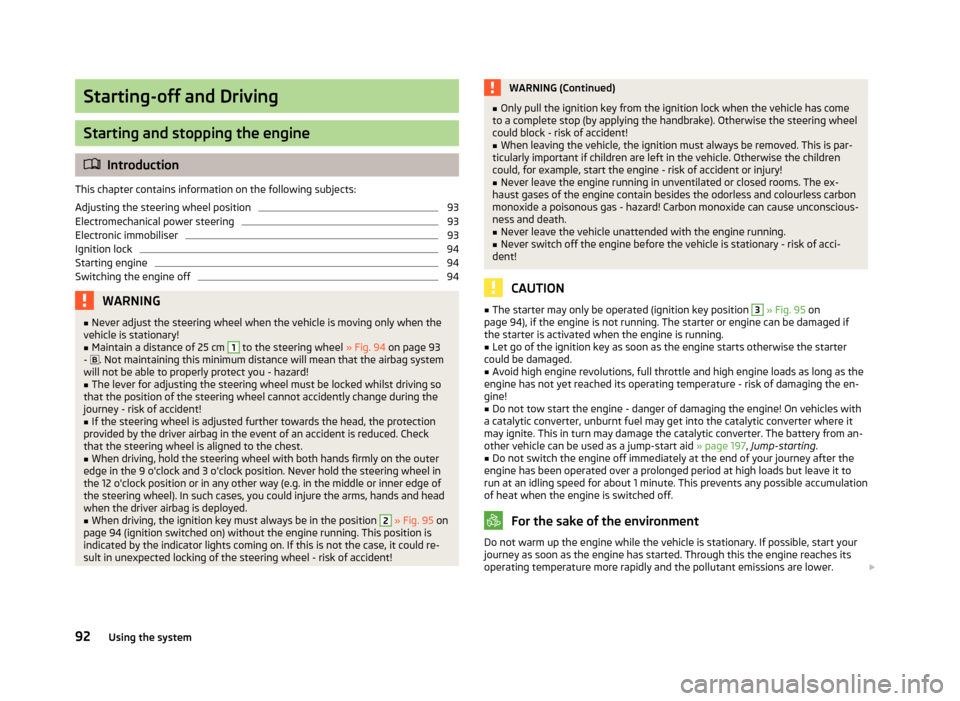
Starting-off and Driving
Starting and stopping the engine
ä
Introduction
This chapter contains information on the following subjects:
Adjusting the steering wheel position 93
Electromechanical power steering 93
Electronic immobiliser 93
Ignition lock 94
Starting engine 94
Switching the engine off 94
WARNING
■ Never adjust the steering wheel when the vehicle is moving only when the
vehicle is stationary!
■ Maintain a distance of 25 cm 1
to the steering wheel
» Fig. 94 on page 93
- . Not maintaining this minimum distance will mean that the airbag system
will not be able to properly protect you - hazard!
■ The lever for adjusting the steering wheel must be locked whilst driving so
that the position of the steering wheel cannot accidently change during the
journey - risk of accident!
■ If the steering wheel is adjusted further towards the head, the protection
provided by the driver airbag in the event of an accident is reduced. Check
that the steering wheel is aligned to the chest. ■ When driving, hold the steering wheel with both hands firmly on the outer
edge in the 9 o'clock and 3 o'clock position. Never hold the steering wheel in
the 12 o'clock position or in any other way (e.g. in the middle or inner edge of
the steering wheel). In such cases, you could injure the arms, hands and head
when the driver airbag is deployed.
■ When driving, the ignition key must always be in the position 2
» Fig. 95 on
page 94 (ignition switched on) without the engine running. This position is
indicated by the indicator lights coming on. If this is not the case, it could re-
sult in unexpected locking of the steering wheel - risk of accident! WARNING (Continued)
■ Only pull the ignition key from the ignition lock when the vehicle has come
to a complete stop (by applying the handbrake). Otherwise the steering wheel
could block - risk of accident!
■ When leaving the vehicle, the ignition must always be removed. This is par-
ticularly important if children are left in the vehicle. Otherwise the children
could, for example, start the engine - risk of accident or injury!
■ Never leave the engine running in unventilated or closed rooms. The ex-
haust gases of the engine contain besides the odorless and colourless carbon
monoxide a poisonous gas - hazard! Carbon monoxide can cause unconscious-
ness and death. ■ Never leave the vehicle unattended with the engine running.
■ Never switch off the engine before the vehicle is stationary - risk of acci-
dent! CAUTION
■ The starter may only be operated (ignition key position 3
» Fig. 95 on
page 94), if the engine is not running. The starter or engine can be damaged if
the starter is activated when the engine is running.
■ Let go of the ignition key as soon as the engine starts otherwise the starter
could be damaged.
■ Avoid high engine revolutions, full throttle and high engine loads as long as the
engine has not yet reached its operating temperature - risk of damaging the en-
gine! ■ Do not tow start the engine - danger of damaging the engine! On vehicles with
a catalytic converter, unburnt fuel may get into the catalytic converter where it
may ignite. This in turn may damage the catalytic converter. The battery from an-
other vehicle can be used as a jump-start aid » page 197, Jump-starting.
■ Do not switch the engine off immediately at the end of your journey after the
engine has been operated over a prolonged period at high loads but leave it to
run at an idling speed for about 1
minute. This prevents any possible accumulation
of heat when the engine is switched off. For the sake of the environment
Do not warm up the engine while the vehicle is stationary. If possible, start your
journey as soon as the engine has started. Through this the engine reaches its
operating temperature more rapidly and the pollutant emissions are lower. £
92 Using the system
Page 95 of 225
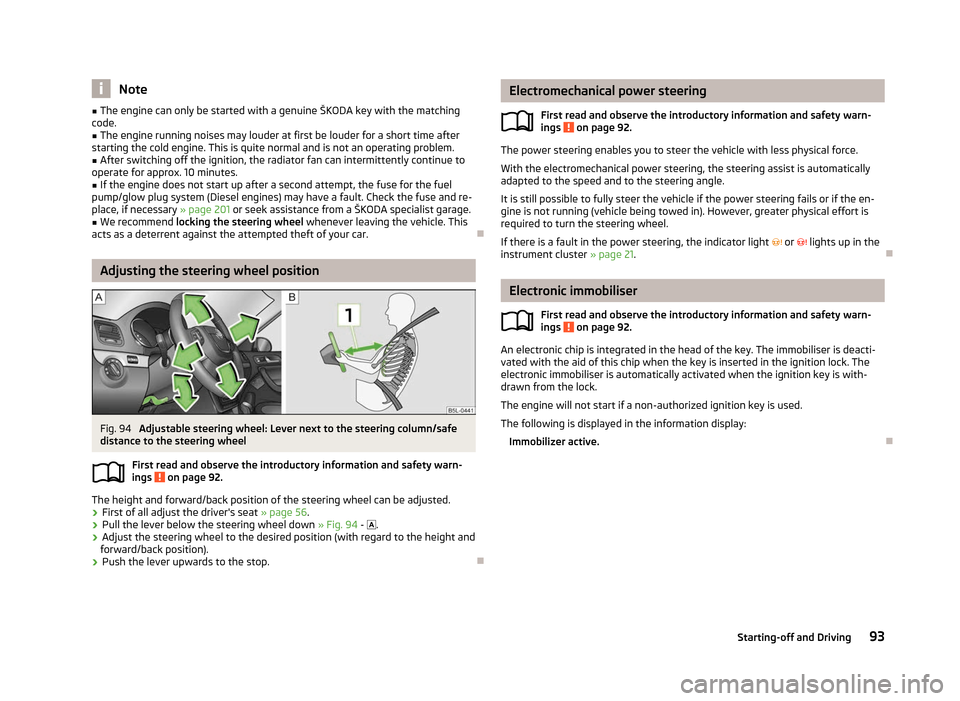
Note
■ The engine can only be started with a genuine ŠKODA key with the matching
code. ■ The engine running noises may louder at first be louder for a short time after
starting the cold engine. This is quite normal and is not an operating problem. ■ After switching off the ignition, the radiator fan can intermittently continue to
operate for approx. 10
minutes.
■ If the engine does not start up after a second attempt, the fuse for the fuel
pump/glow plug system (Diesel engines) may have a fault. Check the fuse and re-
place, if necessary » page 201 or seek assistance from a
ŠKODA specialist garage.
■ We recommend locking the steering wheel whenever leaving the vehicle. This
acts as a deterrent against the attempted theft of your car. ÐAdjusting the steering wheel position
Fig. 94
Adjustable steering wheel: Lever next to the steering column/safe
distance to the steering wheel
First read and observe the introductory information and safety warn-
ings on page 92.
The height and forward/back position of the steering wheel can be adjusted.
›
First of all adjust the driver's seat
» page 56.
› Pull the lever below the steering wheel down
» Fig. 94 - .
› Adjust the steering wheel to the desired position (with regard to the height and
forward/back position).
› Push the lever upwards to the stop. Ð
ä Electromechanical power steering
First read and observe the introductory information and safety warn-
ings on page 92.
The power steering enables you to steer the vehicle with less physical force.
With the electromechanical power steering, the steering assist is automatically
adapted to the speed and to the steering angle.
It is still possible to fully steer the vehicle if the power steering fails or if the en-
gine is not running (vehicle being towed in). However, greater physical effort is
required to turn the steering wheel.
If there is a fault in the power steering, the indicator light or lights up in the
instrument cluster » page 21. Ð Electronic immobiliser
First read and observe the introductory information and safety warn-
ings on page 92.
An electronic chip is integrated in the head of the key. The immobiliser is deacti-
vated with the aid of this chip when the key is inserted in the ignition lock. The
electronic immobiliser is automatically activated when the ignition key is with-
drawn from the lock.
The engine will not start if a non-authorized ignition key is used.
The following is displayed in the information display: Immobilizer active. Ð
ä
ä
93
Starting-off and Driving